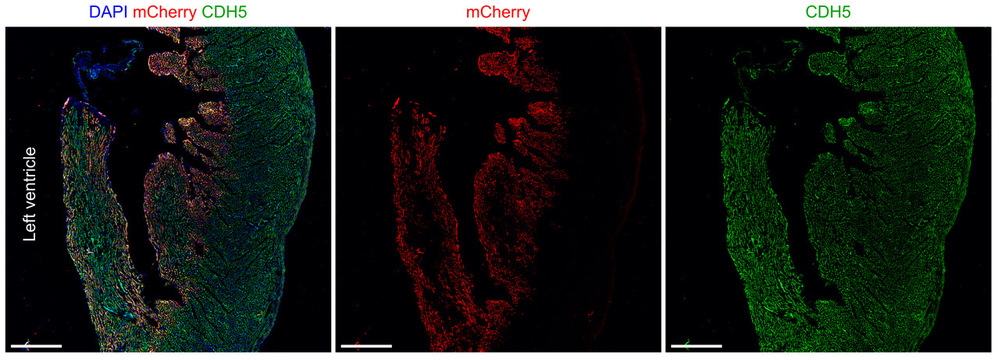A team of scientists led by Professor Zhang Hui from SLST has identified a novel potential therapeutic strategy to treat myocardial infarction. On November 20th, 2020, a paper entitled “Overexpression of Kdr in adult endocardium induces endocardial neovascularization and improves heart function after myocardial infarction” was published online in Cell Research.
The researchers found that endocardial overexpression of Kdr converts adult endocardium into coronary vessels in normal heart and after myocardial infarction. The endocardial conversion into coronary vessels significantly enhanced heart function after myocardial infarction.
Myocardial ischemic infarction resulting from coronary vascular obstruction is a leading cause of mortality and morbidity worldwide. Promoting the formation of coronary vessels is beneficial to the treatment of myocardial infarction. However, the angiogenesis ability of adult coronary vessels is limited, and the therapeutic efficacy of some classic pro-angiogenic drugs is not ideal in patients with myocardial infarction. Finding another way to promote de novo coronary vessel formation in myocardial infarction is urgent.
Endocardium gives rise to part of the coronary vessels during development. However, endocardium loses this ability in adult stage. The researchers compared endocardial cells in the embryonic, neonatal, and adult stages, and found that the expression level of KDR (also known as VEGFR2) protein in the endocardium gradually decreased with the development of the heart. The researchers suspected that decreased KDR expression might be related to the lost vessel-generating ability of adult endocardium.
To verify this hypothesis, the researchers generated a Npr3-CreER;H11-loxp-stop-loxp-kdr-2A-mCherry mouse model tospecifically express KDR-encoding gene Kdr in adult endocardium and simultaneously trace the fates of endocardial cells. The researchers found that long-term (half a year) overexpression of Kdr led to substantial endocardial-derived coronary blood vessels in normal heart.
More importantly, Kdr-overexpressing endocardium generated new coronary vessels within a short period of time (7 to 28 days) after myocardial infarction, probably due to the highly expressed VEGFA in the infarcted heart. Endocardial conversion into coronary blood vessels after infarction reduced cardiomyocyte apoptosis, decreased the fibrotic areas, and improved heart function. This study revealed that adult endocardial cells still possess the potential to generate coronary vessels, which makes them a target for the promotion of coronary vessel formation after myocardial infarction.
This work was sponsored by grants from the National key R&D Program of China, National Science Foundation of China, the “Shuguang Program” supported by Shanghai Education Development Foundation and Shanghai Municipal Commission, and the ShanghaiTech University start-up fund.
Article link: https://www.nature.com/articles/s41422-020-00436-y

Lineage tracing experiments revealed that adult endocardium with overexpression of Kdr generated coronary blood vessels in normal hearts. mCherry indicates Kdr-overexpressing endocardium and endocardial-derived coronary endothelial cells. CDH5 indicates endocardial and coronal vascular endothelial cells.

